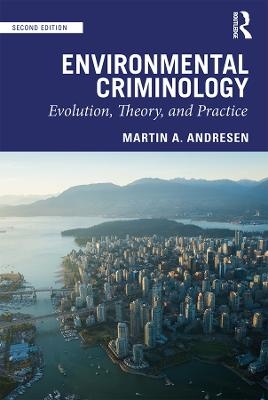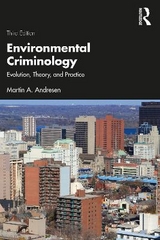
Environmental Criminology
Routledge (Verlag)
978-1-138-31701-7 (ISBN)
- Titel erscheint in neuer Auflage
- Artikel merken
The field of environmental criminology is a staple theoretical framework in contemporary criminological theory. This fully revised and expanded edition of the world’s first comprehensive and sole-authored textbook on this influential school of criminological thought covers a wide range of topics, including:
the origins of environmental criminology;
the primary theoretical frameworks, such as routine activity theory, geometry of crime, rational choice theory, and the pattern theory of crime;
the practical application of environmental criminology;
an examination of how theories are operationalized and tested; and
policy implications for the practice of crime prevention.
As well as these popular topics, Martin Andresen also discusses a number of topics that are at the leading edge of research within environmental criminology. New to the second edition are chapters on empirical support for the various models of crime prevention covered and on the growing literature on "the journey to crime".
This text will be ideal for courses on crime prevention, where students are often encouraged to consider policy problems and apply theory to practice. This book offers up environmental criminology as a theoretical framework for making sense of complex neighborhood problems, so it is also perfect for courses on geography of crime, crime analysis, and, indeed, environmental criminology. It would also be a good supplement for courses on criminological theory.
Martin A. Andresen is Associate Professor in the School of Criminology and Criminal Justice at Griffith University. His research areas are in spatial crime analysis, crime and place, geography of crime, environmental criminology, and applied spatial statistics and geographical information analysis. Within these research areas he has published three edited volumes, two books, and more than 100 refereed journal articles and contributions to edited volumes.
Part 1 Early work on the ecology of crime; 1. The beginnings of the geography of crime; 2. Social disorganization theory; Part 2 Theories within environmental criminology; 3. Routine activity theory; 4. Geometry of crime; 5. Rational choice theory; 6. Pattern theory of crime; 7. Crime prevention: theory; Part 3 The practice of environmental criminology; 8. Crime prevention: implementation, evaluation, and empirical evidence; 9. Crime measurement; 10. Spatial issues with crime analysis; 11. Hot spots of crime; 12. The temporal dimension of crime; 13. Environmental criminology and the crime drop; 14. Geographic profiling; 15. (Near-) repeat victimization; 16. Journey to crime; 17. Crime and place
| Erscheinungsdatum | 05.03.2019 |
|---|---|
| Zusatzinfo | 9 Tables, black and white; 87 Line drawings, black and white; 2 Halftones, black and white; 89 Illustrations, black and white |
| Verlagsort | London |
| Sprache | englisch |
| Maße | 156 x 234 mm |
| Gewicht | 544 g |
| Themenwelt | Naturwissenschaften ► Biologie ► Ökologie / Naturschutz |
| Recht / Steuern ► Strafrecht ► Kriminologie | |
| ISBN-10 | 1-138-31701-2 / 1138317012 |
| ISBN-13 | 978-1-138-31701-7 / 9781138317017 |
| Zustand | Neuware |
| Informationen gemäß Produktsicherheitsverordnung (GPSR) | |
| Haben Sie eine Frage zum Produkt? |
aus dem Bereich



